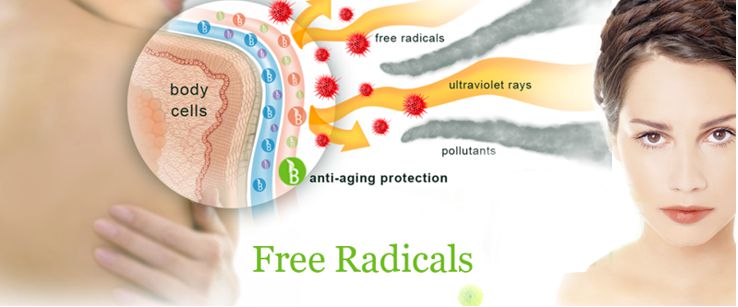Dr. Denham Harmon, M.D., Ph.D., was the first person to propose that arbitrary chemical reactivity of free radicals could potentially be a cause of random biological damage, namely the aging process. His theory eventually became a major theory of the aging process. His theory also involved the implication that prevention of free radicals from oxidizing sensitive biological molecules would slow the aging process.
So that is all fine and good – but, what is a free radical?
A free radical is an atom that has an odd number of electrons in its outer ring. It is lacking an electron in the outer ring, which makes it positively charged. It is called a “free radical” because atoms usually contain paired electrons.
If all of this is a little too scientific, then focus on how free radicals can cause damage and stimulate the aging process.
- Free radicals do not adhere to the normal processes within the body.
- They are chemically reactive and very unstable in the body.
- They react with other molecules and then a rapid reproduction of free radicals begins.
- Once this happens, there becomes an over-abundance of these free radicals.
- The multiplication of free radicals is now underway!
This process is also considered a chain reaction and it contributes to the aging process. It impacts DNA and eventually causes cells to die and disrupts the reproduction of new cells. They are particularly susceptible to reaction with toxic metals in the body and environmental agents that enter the body.
As Dr. Olshansky notes:
“Cell metabolism produces damaging substances called “free radicals” (mitochondria waste products), which are around doing random damage to the cell itself and other parts of the body……And that damage is what we see as the effects of aging.”
Now you can better understand how the combination of free radicals and external factors can accelerate the aging process. Toxic chemicals and environmental agents are produced by alcohol consumption, smoking, pesticides, lead, and other external factors. They complicate and escalate the damaging process created and stimulated by free radicals.
As free radicals rampage through the body, destroying cells and slowing cell reproduction, they begin to cause many problems, and are suspected to be related to:
- Heart disease
- Cancer
- Alzheimer’s Disease
- Parkinson’s Disease
This is when antioxidants become important factors in managing the aging process. They can help to offset or diminish the role of free radicals in the body by serving as a sort of sponge for the free radicals.
The important points to understand from our review of free radicals are that:
- their development occurs naturally within the body, and
- they can escalate the aging process.
They can damage DNA, which is a partial cause of the aging process. DNA is the central theme in the building blocks of all human beings. Knowing this, we must find ways to deter or minimize the damage caused by free radicals.
Although these are only a partial cause of the aging process, free radicals can be a big factor for some people.
